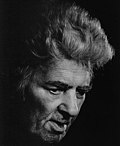20th century
- Ali Abdolrezaei (علی عبدالرضایی)
- Abdolali Dastgheib, author (عبدالعلی دستغیب)
- Abdumalik Bahori, Tajik-Persian poet
- Abdolkarim Soroush, philosopher
- Abolghasem Lahouti, communist poet (ابوالقاسم لاهوتی)
- Adib Boroumand, poet, politician, and lawyer (ادیب برومند)
- Ahmad Kamyabi Mask, writer and translator (احمد کامیابی مَسْک)
- Ahmad Kasravi (احمد کسروی)
- Ahmad NikTalab, poet and linguist (احمد نیکطلب)
- Ahmad Raza Khan (احمدرضا خان)
- Ahmad Shamlou (احمد شاملو), poet

Ahmad Shamlou - Akram Fahimian, poet (اکرم فهیمیان)
- Ali Akbar Dehkhoda, linguist (علیاکبر دهخدا)
- Ali Mohammad Afghani, writer (علیمحمد افغانی)
- Ali Shariati, sociologist and theologian (علی شریعتی)
- Aref Qazvini (عارف قزوینی)
- Asad Gulzoda, poet
- Aziz Motazedi, novelist (عزیز معتضدی)
- Bahman Sholevar, writer and poet (بهمن شعلهور)
- Bahram Bayzai, playwright (بهرام بیضایی)

Bahram Bayzai - Bijan Elahi, poet and translator
- Bilal Yousaf, writer, critic
- Bozor Sobir, poet (بازارصابر)
- Bozorg Alavi, writer (بزرگ علوی)
- Dariush Shayegan (داریوش شایگان)
- Ebrahim Nabavi, satirist (ابراهیم نبوی)
- Ehsan Naraghi, Scholar, sociologist and writer
- Esmail Khoi, Poet
- Ezzat Goushegir
- Farzona, poet (Fаrzonа/فرزانه)
- Farzaneh Aghaeipour (فرزانه آقاییپور)
- Fereidoon Tavallali, poet (فریدون توللی)
- Fereshteh Ahmadi, writer (فرشته احمدی)
- Fereydoun Moshiri, poet (فریدون مشیری)
- Forough Farrokhzad, poet (فروغ فرخزاد)
- Ghazaleh Alizadeh, novelist (غزاله علیزاده)
- Gholam Hossein Saedi, writer
- Gholamhossein Mosahab, encyclopedist (غلامحسین مصاحب)
- Gholamreza Rouhani, Poet (غلامرضا روحانی)
- Gulnazar Keldi, Tajik poet
- Hamid Mosadegh (حمید مصدق)
- Hassan Roshdieh (حسن رشدیه)
- Hassan Kamshad
- Heydar Raqabi (حیدر رقابی)
- Heydar Yaghma (حیدر یغما)
- Homaira Nakhat Dastgirzada (حمیرا نکهت دستگیرزاده)
- Houshang Golshiri (هوشنگ گلشیری)
- Houshang Moradi Kermani (هوشنگ مرادی کرمانی)
- Hushang Ebtehaj (H. A. Sayeh) (هوشنگ ابتهاج)
- Ibrahim Ali Tashna, Bengali poet (تشنه)
- Ismail Alam, Bengali poet (اسماعیل عالم)
- Iraj Mirza, poet (ایرج میرزا)

Iraj Mirza - Iraj Pezeshkzad, novelist (ایرج پزشکزاد)
- Jalal Al-e-Ahmad (جلال آل احمد)
- Zhaleh Amouzegar (ژاله آموزگار)
- Kazim Yazdani, author and historian (حاج کاظم یزدانی)
- Khalilullah Khalili, poet and writer (خلیلالله خلیلی)
- Kioumars Saberi Foumani (کیومرث صابری فومنی)
- Loiq Sher-Ali (لائق شیرعلی), poet from Tajikistan
- Leila Kasra, poet and lyricist
- Mahbod Seraji, Writer (مهبد سراجی)
- Mahmoud Dowlatabadi (محمود دولت آبادی)
- Mahmoud Melmasi - Azarm, poet (محمود ملماسی، آزرم)
- Majid Adibzadeh, writer and scholar (مجید ادیبزاده)
- Majid M. Naini writer, poet, translator, speaker (مجید نایینی)
- Mana Aghaee, poet, author and translator (مانا آقایی)
- Manouchehr Atashi (منوچهر آتشی)
- Marjane Satrapi, graphic novelist
- Maryam Jafari Azarmanipoet, critic (مریم جعفری آذرمانی)
- Massoud Behnoud (مسعود بهنود), journalist
- Mehdi Akhavan-Sales, poet (مهدی اخوان ثالث)
- Mina Assadi, poet, author, journalist, and songwriter (مینا اسدی)
- Mina Dastgheib, poet (مینا دستغیب)
- Rosa Jamali, poet, playwright, translator
- Hamideh Jahangiri, Author, translator, Academic (حمیده جهانگیری)
- Mirzadeh Eshghi (میرزاده عشقی)
- Mirzo Tursunzoda, Tajik poet
- Mohammad Ali Jamalzadeh, writer and novelist (محمدعلی جمالزاده)
- Mohammad Hejazi, novelist and playwright
- Mohammad Hossein Shahriar, poet (محمدحسین شهریار)
- Mohammad Jafar Pouyandeh (محمدجعفر پوینده)
- Mohammad Mokhtari (محمد مختاری)
- Mohammad Reza Ali Payam (Haloo), poet (محمدرضا عالیپیام)
- Mohammad Reza Shafiei-Kadkani, poet (محمدرضا شفیعی کدکنی)
- Mohammad-Amin Riahi, scholar and writer (محمدامین ریاحی)
- Mohammad-Reza Shafiei-Kadkani, poet
- Mohammad-Taghi Bahar, poet(محمدتقی بهار)
- Monica Malek-Yonan, playwright
- Morteza Motahhari, theologian (مرتضی مطهری)
- Muhammad Faizullah, Bengali poet (محمد فیضالله)
- Muhammad Iqbal, Pakistani poet (محمد اقبال)
- Nader Naderpour, poet (نادر نادرپور)
- Nasrollah Mardani, poet (نصرالله مردانی)
- Nima Yushij, poet (نیما یوشیج)
- Nosrat Rahmani, poet (نصرت رحمانی)
- Parvin E'tesami, poet (پروین اعتصامی)
- Qasim Akhgar, Author, journalist and political activist (قسیم اخگر)
- Rahi Mo'ayeri, poet (رهی معیری)
- Reza Baraheni, poet and critic (رضا براهنی)
- Reza Khoshnazar, novelist (رضا خوشبین خوشنظر)
- Reza Gholi Khan Hedayat, poet and historian (رضاقلیخان هدایت)
- Reza Shirmarz, playwright, author, translator, poet and essayist (رضا شیرمرز)
- Roya Hakakian, poet, writer, journalist (رؤیا حکاکیان)
- Saboktakin Saloor, novelist
- Sadegh Choubak, writer (صادق چوبک)
- Sadegh Hedayat (صادق هدایت)
- Sadriddin Ayni (صدرالدین عینی), Tajikistan's national poet and one of the most important writers of the country's history.
- Saeed Nafisi, scholar, poet and writer
- Sahar Delijani, novelist (سحر دلیجانی)
- Samad Behrangi, writer (صمد بهرنگی)
- Seyed Morteza Hamidzadeh, writer (سید مرتضی حمیدزاده)

Seyed Morteza Hamidzadeh - Seyed Ali Salehi, poet
- Sems Kesmai, poet (شمس کسمایی)
- Shahrnush Parsipur, novelist (شهرنوش پارسیپور)
- Shams Langeroodi, poet (شمس لنگرودی)
- Shamim Hashimi, poet and writer (شمیم ہاشمی)
- Shapour Bonyad, poet (شاپور بنیاد)
- Sheema Kalbasi, poet and translator (شیما کلباسی)
- Siavash Kasraie poet (سیاوش کسرایی)
- Simin Behbahani, poet (سیمین بهبهانی)
- Simin Daneshvar, writer (سیمین دانشور)
- Sipandi Samarkandi, Tajik bilingual poet
- Sohrab Sepehri, poet and painter (سهراب سپهری)

Sohrab Sepehri - Syed Waheed Ashraf, Poet, Sufi, Scholar, Critic
- Syed Abid Ali Abid Poet and Author
- Temur Zulfiqorov, Tajik poet (Temur Zulfiqorov)
- Varand, poet (واراند)

Varand - Yadollah Royaee, poet (یدالله رویایی)
- Abdolhamid Ziaei poet, writer (عبدالحمید ضیایی)
- Hossein Rajabian, Playwright (حسین رجبیان)
- Yasmina Reza, poet (یاسمینا رضا)
- Zoya Pirzad novelist (زویا پیرزاد)
- Niloufar Talebi (نیلوفر طالبی)
- Sholeh Wolpé poet, playwright (شعله ولپی)
- Iraj Zebardast, poet (ایرج زبردست)





